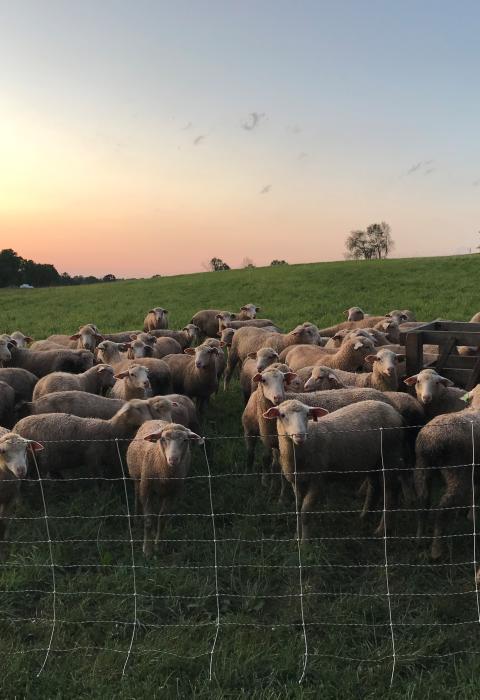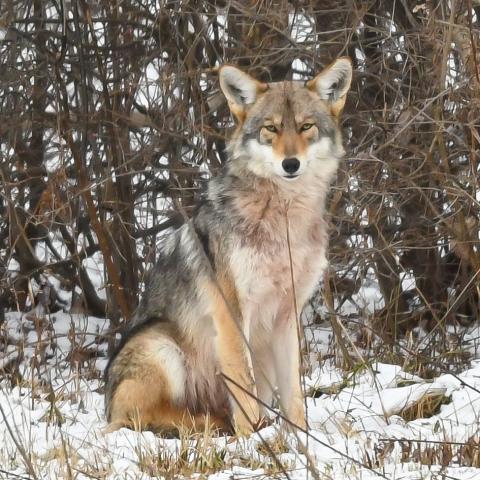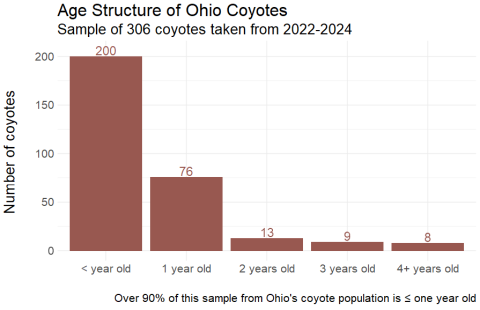Coyote Ecology and Management Research
Since coyotes are relatively new in the eastern United States, there has been little research done on their ecology and behavior in states like Ohio. Some of the research done in western states (the coyote's historic range) may apply to coyotes in the East, but the differences in habitat, climate, and species of animals present suggest that eastern coyotes may behave differently and in unexpected ways. Understanding these differences is important for management of the species.
This project is a collaboration between The Ohio State University's School of the Environment and Natural Resources and the Division of Wildlife at the Ohio Department of Natural Resources. We are working with livestock producers, hunters, trappers, and other experts from around the state to better understand Ohio's coyotes, what they are eating, and how they are impacting livestock production. For the past several years, our project's research has involved investigating coyote diets (and how much of that diet may include domestic livestock) and getting an idea of the age structure and reproductive rates of Ohio's coyote population. We are now moving on with a third component of the project, where we are investigating movement and behavior of Ohio's coyotes.
Movement and Behavior
The current focus of the project is to investigate how coyotes move and behave. Particularly, we aim to work with livestock producers in Ohio to better understand how coyotes are behaving around livestock operations. This involves putting GPS collars on coyotes to explore things like:
- how they respond to different husbandry methods,
- are they avoiding livestock operations and human activity,
- are they more active around pastures during certain times of day or year.
In addition to informing potential ways to manage coyotes, this gives us important insight into how they generally live their lives. Less intuitively, but just as important, these GPS collars can tell us how they die. It may be the case that certain groups of individuals, for example very young coyotes, are more likely to be hit by cars or are less wary of hunters due to lack of experience. The GPS collar will send out a specific signal if it has not moved in a while - suggesting that animal may be dead. We can then retrieve the collar, assess cause of death, and collect data on exactly how old that animal was when it died. By looking at mortality this way, we avoid the potential bias that comes from sampling predominantly inexperienced animals.
Diet
A major component of our research is investigating what coyotes in Ohio eat and how much of their diet consists of livestock. To do this, we perform necropsies (like an autopsy in humans) on road-killed and legally harvested coyotes to determine what is in their stomachs. This gives us concrete evidence of diet, but only in terms of what that individual has eaten very recently. We are also using whiskers for stable isotope analysis, which gives us diet information over a much wider window of time - several months to a year - to identify patterns in diet composition throughout the breeding and lambing/calving season. We hope to combine these two methods to get a detailed view of coyote diet and how it changes over time.
Diet Analysis
Animals are what they eat! All food items are made of molecules, from the fiber and sugar in plants to the proteins in animal tissue. Molecules are made of elements like carbon and nitrogen. In nature, some elements have different forms that are heavy or light. Their different weights mean that they react differently when they are put together to make molecules. That means all food items have a unique signature of the heavy and light forms of the elements that make them. Animals need to eat different types of food to grow. They take in their food, break down the molecules in the food, and use those molecules to add new fur, grow longer nails, build bigger muscles, make new red blood cells, and grow longer bones. So, that unique signature in the food is now in the animal’s fur, nails, muscle, blood, and bones. If we know the unique signature in different food items and have a sample from the animal we are studying, we can use math to determine how much of each food item the animal eats as part of their diet. This is called stable isotope analysis.
Stable isotope analysis requires us to have samples from coyotes and their prey. Since coyotes can eat almost anything, we must sample many different prey items to assess coyote diets better. So far, we have collected samples from 43 potential prey species and several varieties of natural fruits that coyotes might eat. Now, our team is working on analyzing these samples to learn more about what coyotes in different parts of the state are consuming.
Population Demographics
Seemingly basic questions, such as the age distribution and reproductive rates, can tell us a lot about a population of animals. Age structure is an indication of the stability of the population. Reproductive rates allow us to consider population growth rates. All of these things are important to understand for us to manage the species properly.
Age Structure
A population's age structure, or the distribution of animals that are very young compared to those that are older, can inform the management of a species. For example, if a large proportion of the population is made up of older individuals, then survival of mature adults is relatively high. In the case of territorial animals like coyotes, these older adults are generally maintaining more stable territories. In contrast, our sample of over 300 coyotes from around the state indicates that our population is very young: the majority of coyotes in our sample were juveniles (less than a year old). A population with mostly young individuals means that adult survival is relatively low, with few coyotes living longer than a year or two. This means that territories are likely changing frequently, with territory-holding coyotes dying and newcomers taking over.
This contributes to what many people have observed about coyote management - they're hard to control. Despite high hunting pressure, vehicle collisions, and other sources of mortality, coyotes persist on the landscape. Not only are they reproducing at a high enough rate to sustain the population, but this continuous shifting of territories allows transient individuals (solitary coyotes with no established territory) to quickly stake a claim on an area where coyotes have recently been removed.
How Do We Know Age?
We look at the level of wear on a coyote's teeth to get an idea of how old that individual is. They crunch through prey - bones and all - so their teeth get worn down pretty quickly. When possible, we collect a tooth from carcasses for detailed aging by cementum annuli - similar to tree rings that develop in teeth as individuals age. This gives us the age of each individual, so we can calculate roughly what percentage of the population is made up of adults, subadults (year old), or juveniles.
Reproductive Rate
One way that coyotes persist in areas that have high hunting pressure is by increasing reproduction, including larger litter sizes and females reproducing at a younger age than females from populations without that pressure. To get an idea of which of these reproductive increases is occurring in Ohio (or if it is another mechanism entirely), we do necropsies on road-killed and legally-harvested animals and look at their reproductive tracts. If a female is very young (as determined by the tooth aging mentioned above), but her reproductive system appears active, then we can assume that females are beginning to breed earlier. There are also placental scars left on a female's reproductive tract after she has had a litter of pups - one for each pup, more or less. By counting these, we can get counts of litter sizes.
Hunting pressure, road mortality, and other dangers to coyotes are not uniform across the state. We may find that different mechanisms are active in different regions and habitats, depending on the local pressures. For this reason, we try to get samples from as many areas of the state as possible, so that we can account for these sources of variation. Incorporating this variation is important for effective management applicable at a local scale.



